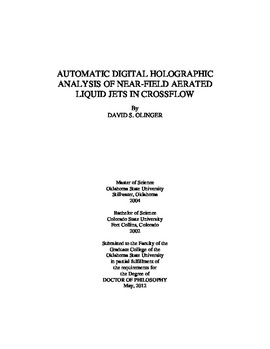| dc.contributor.advisor | Sallam, Khaled A. | |
| dc.contributor.author | Olinger, David Simon | |
| dc.date.accessioned | 2013-12-10T18:05:21Z | |
| dc.date.available | 2013-12-10T18:05:21Z | |
| dc.date.issued | 2012-05 | |
| dc.identifier.uri | https://hdl.handle.net/11244/7814 | |
| dc.description.abstract | Scope and Method of Study: | |
| dc.description.abstract | This report has discussed the advantages that holography has over other spray diagnostic approaches; namely, holography is a volumetric measurement as opposed to a point measurement and drops are not limited to a particular shape. This project has advanced holographic spray analysis by automating the image processing algorithms. The program was then applied to sprays in a realistic testing environment. Aerated liquid jets in a high subsonic crossflow were analyzed, including the rarely investigated near injector region (from the injector to the far field, x/d = 0..100). Usable data was presented in a variety of figures. These results demonstrate that practical 3D analysis of sprays has been pushed well into the near injector region, specifically up to x/d ~ 15. Additional data was obtained even closer to the injector, but its confidence drops significantly. | |
| dc.description.abstract | Findings and Conclusions: | |
| dc.description.abstract | The hologram image processing algorithm has been validated and its uncertainty quantified. The drop detection false positive rate is 6% and false negative rate is 20%. These detection rates are independent of the drop size, for drop images with a diameter greater than six pixels. | |
| dc.description.abstract | The area near the injector floor in the figures are composed of a high number density, wide span of very small droplets separated from the main, high density core. This region immediately downstream of the injector, under the jet core, features a continuous distribution of drops. Hence, while a wake of relatively large drops forms downstream of the injection site, the near-field wake is not completely empty. | |
| dc.description.abstract | The downstream location is important to the Sauter Mean Diameter in the near field; larger drops break up during secondary atomization. However, even with the near field data, the influence of x is much less than GLR or M for the given data set. SMD is inversely proportional to all three factors. | |
| dc.format | application/pdf | |
| dc.language | en_US | |
| dc.rights | Copyright is held by the author who has granted the Oklahoma State University Library the non-exclusive right to share this material in its institutional repository. Contact Digital Library Services at lib-dls@okstate.edu or 405-744-9161 for the permission policy on the use, reproduction or distribution of this material. | |
| dc.title | Automatic digital holographic analysis of near-field aerated liquid jets in crossflow | |
| dc.contributor.committeeMember | Arena, Andrew S. | |
| dc.contributor.committeeMember | Cheng, Qi | |
| dc.contributor.committeeMember | Hanan, Jay C. | |
| dc.contributor.committeeMember | Hoberock, Lawrence L. | |
| osu.filename | Olinger_okstate_0664D_12104.pdf | |
| osu.accesstype | Open Access | |
| dc.type.genre | Dissertation | |
| dc.type.material | Text | |
| dc.subject.keywords | atomization | |
| dc.subject.keywords | drop | |
| dc.subject.keywords | hologram | |
| dc.subject.keywords | holography | |
| dc.subject.keywords | jet | |
| dc.subject.keywords | spray | |
| thesis.degree.discipline | Mechanical and Aerospace Engineering | |
| thesis.degree.grantor | Oklahoma State University | |
